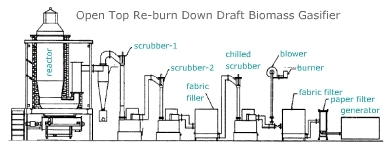Biomass gasification systems to power thousands of villages in India
Jonas Van Den Berg, Biopact Blog, September 10, 2006
Courtesy of Paul Anderson
The Indian Institute of Science (IISc) has announced an agreement with Cummins India for the commercialisation and distribution of biomass gasification power generation systems that can be used to bring electricity to thousands of villages in rural India in a sustainable, decentralised and renewable way.
Under the agreement, Cummins India and IISc will jointly work on the integrated development and release of power generation systems based on so-called "Open Down Draft" biomass gasification systems [*.pdf] developed by the IISc. Cummins India will launch a new range of generator sets, which would work on gasifiers designed using the technology. The generator sets will be available in a range of ratings starting from 25 kWe, and extend to multiple unit power plants over 1.5 MWe.
Rural India has a large biomass stock, a low-cost and sustainable fuel source, and gasification technologies are one of the most versatile conversion methods to utilize this energy potential. Prof P.J. Paul, IISc Bangalore, says that "Our technology package known as `Open Top Re-burn Down Draft Biomass Gasifier' generates gas from a range of biomass sources that comprises forest residue, agricultural residue, bagasse, and so on. The Ministry of Non-Conventional Energy Sources (MNES) has estimated more than 1,700 MW potential for producer gas as fuel from biomass which can help power the more than 125,000 villages that are unelectrified today."
Some background to this solid biofuel conversion technology, which is also known as 'gengas', 'generator gas', 'producer gas' or 'wood gas' technology:
The principle of downdraft gasification was developed during World War II, when there was a shortage of petroleum fuels. Cars ran on charcoal, via a gasifier that most often was placed back in the car. However, this technology was only an emergency solution as it required much knowledge and maintenance. When petroleum fuels became readily available after the war, gasification technology for cars was abandoned.
During the 70's, small-scale gasification caught new attention for application in developing countries. Electricity is the basis for the modern society and essential in a household to provide quality of life. Many of these countries have rural electrification programmes to extend the electrical grid to all people, but often it may be more expensive to extend the national grid than finding a local solution, especially for remote areas. Very often, the countries lack infrastructure and means, and furthermore there is often shortage of petroleum fuels.
One solution to power a village is to build a small local power plant. A gasifier, running on local biomass, may power a stationary engine to produce mechanical power, either for pumping water or to generate electricity. A considerable number of gasifier-engine plants have been installed in the developing world with funds from foreign aid organisations. Some are successful, but many do not work properly and cause engine failures. To operate the technology, knowledge and skills are needed to regularly register parameters like temperatures, pressures, flows and gas composition. It is also essential to optimise gasifier designs, before connecting an engine or a genset to it.
So biomass gasification technologies have been around for the past three decades, but they have not been optimised for use by rural people. The collaboration between the IIsc and Cummins signals that large-scale commercialisation of the technology with products designed for optimised operations and uptime is now finally being taken seriously.
This comes at a time when India is actively turning towards bioenergy and biofuels as alternatives to fossil fuels, with several different bioconversion technologies being the focus of intense research and development, and policy work (see India's National Biomass Gasifier Program).
This energy system not only utilizes biomass in a way that makes it competitive with fossil fuels, but it also saves CO2 emissions and reduces SOx and NOx gasses. As such, it makes for a good candidate for Clean Development Mechanism projects.
Mr Rampraveen Swaminathan, vice-president of Cummins India, said that "Cummins is committed to developing power generation technologies based on lower cost and sustainable fuels. This initiative provides a significant lifecycle cost advantage over hydrocarbon fuels and also enables us to develop sustainable energy systems: "Over the past two years we have been working on making several changes in our engine and genset designs to ensure that our products meet desired efficiency levels. The systems can provide power plants up to 1.5 MWe which makes it a very attractive option for industry as well."
Under the agreement, Cummins India will manufacture pre-integrated generator sets, which will be used in projects developed internally or through licensees approved by IISc for manufacture of gasification systems.
More information:
IISc, Centre for Sustainable Technologies, 2004, http://biopact.com/2006/09/
images/downdraftbiomassgasifier.jpg

